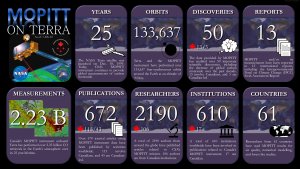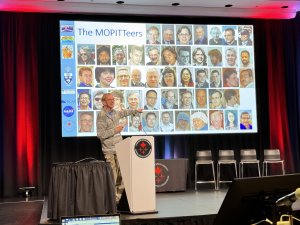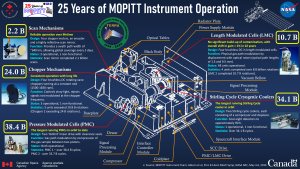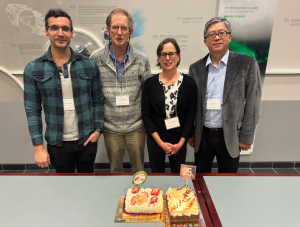
MOPITT at twenty-five: celebrating a quarter century of science
– By Paul Jeffery –
MOPITT: A brief history

National Aeronautics and Space Administration’s (NASA’s) Terra satellite, the flagship satellite of NASA’s Earth Observing System (EOS) program, was launched on 18 December 1999 into a sun-synchronous low-Earth orbit. Aboard Terra are five instruments, including Measurements Of Pollution In The Troposphere (MOPITT), the Canadian contribution to the Terra mission. MOPITT was the first space-based instrument designed for the continuous monitoring of carbon monoxide (CO) on a global basis. A correlation radiometer, MOPITT measured upwelling infrared radiation in both the thermal (TIR; 4.7 mm) and near-infrared (NIR; 2.3 mm), which together are used to derive CO profile and column estimates. MOPITT and the Terra mission was originally intended to operate over a five-year mission lifetime, concluding in December 2004; however, it continued to provide valuable data for over two more decades, generating the longest global record of CO in history.
The longevity of MOPITT did not come without a few hurdles, from a cryocooler displacer failure in May 2001 to the failure of one of its pressure-modulated cells in August 2024, but the instrument team handled each issue as it arose and MOPITT’s operations were successfully adapted to these changes. Unfortunately, a new threat to the instruments aboard Terra arose over the last few years. Due to a series of solar array shunt failures, which slowly lowered the available power, instrument and satellite operations had to be altered to reduce power consumption. Despite the best efforts of NASA and each instrument team, it was ultimately decided that one of the instruments needed to be turned off for the good of the remaining instruments. MOPITT scientific measurements were stopped on 1 February 2025 as MOPITT was put into SAFE mode, and on 9 April 2025, MOPITT was put into SURVIVAL mode at 10:37 am EDT and then ultimately turned off at 3:37 pm EDT. The twenty-five years of CO measurements from MOPITT have contributed to nearly 700 published studies and will continue to be used, as the preeminent record of CO in the early twenty-first century, for many years to come.
Coincidently, to commemorate MOPITT’s twenty-fifth anniversary, the Canadian Space Agency (CSA) held a meeting to celebrate MOPITT’s scientific achievements, its contributions to national and international environmental policy, current and ongoing work using MOPITT measurements, and the groundwork it lay for latter CO monitoring instruments. The meeting was held on 10 – 11 April 2025 at the CSA’s headquarters in Longueuil, Quebec and saw contributions from academia, government, and industry. Highlights, as they pertain to MOPITT, from among this wide array of organizations and institutions represented include:
- NASA – who manage the Terra mission,
- US National Center for Atmospheric Research (NCAR) – who process MOPITT data,
- University of Toronto (UofT) – who monitor MOPITT and interface with NASA and the Terra mission,
- COM DEV (now part of Honeywell Aerospace) – who built MOPITT.
Outside of those linked directly to MOPITT, other participants came from eight other organizations/institutions spread across five countries.
MOPITT Anniversary Meeting: Day 1

The first day of the meeting began with opening remarks from Guennadi Kroupnik [CSA; director general of space utilization], followed by a series of talks from Ken Jucks [program manager for the Upper Atmosphere Research Program at NASA], Jim Drummond [Dalhousie University and UofT; Canadian PI of MOPITT], and Helen Worden [NCAR; US PI of MOPITT] focused on the successful twenty-five years of Terra, MOPITT operations, and MOPITT CO measurements respectively. The session concluded with an overview of the design, construction and integration of MOPITT onto Terra by John Hackett [previously at COM DEV International during MOPITT’s development]. This broad retrospective, focused on the successes of MOPITT, was aptly timed as news of MOPITT being turned off was disseminated, providing a counterpoint to this unfortunate news that focused on the myriad ways MOPITT exceeded expectations over its twenty-five year history. As Jim Drummond shared, when he first proposed the idea for MOPITT he was met with a substantial amount of skepticism over the viability of measurements of tropospheric CO, but after more than twenty-five years of operation MOPITT proved more than capable of mollifying those initial concerns.
The history of MOPITT prior to the launch of Terra was the focus in the second session of the day. The first three talks of the session were by John Gille [NCAR; original US PI of MOPITT], Jim Drummond, and John Hackett. This MOPITT retrospective started in 1987, the year when Jim Drummond and John Gille first began to work on what would become the driving principles of the MOPITT measurements. This work was spurred originally as an academic challenge as to how to make accurate measurements of CO in the troposphere and developed into an agreement wherein Jim Drummond, his team at UofT, and the CSA would build and test MOPITT while John Gille, his team at NCAR, and NASA would develop and support the algorithms needed to retrieve CO from MOPITT’s measurements. The historical retrospective continued to the proposal and subsequent acceptance of MOPITT for NASA’s EOS program in 1988 and 1989 respectively, and finally to the design and testing of MOPITT in the 1990’s. Within these latter topics, details of the challenges faced in the design and construction of MOPITT were explored by Jim Drummond and John Hackett. Emphasis was placed on the astounding twenty-two mechanisms that continued to function within MOPITT over billions of cycles, including how they were synchronized to compensate for vibrations, the packaging of eight optical channels into the instrument, the new (at the time) technologies explored for MOPITT, and the testing that took place at COM DEV International and at UofT’s Instrument Calibration Facility.
Following the retrospective of the design and construction of MOPITT, David Edwards [NCAR] presented on the development of the MOPITT CO retrieval algorithms, with emphasis that MOPITT was the “first operational space-based monitor of chemistry and pollution”, and as such became a pathfinder for space-based instrument characterization, retrieval algorithm efficiency, data validation and comparison, and much more. This second session concluded with an in-memoriam presentation given by Jiansheng Zou [UofT; MOPITT Instrument Operation Team] for Florian Nichitiu [UofT; MOPITT Instrument Operation Team], who was the primary Instrument Operation Team member between 2001 and his retirement in 2018 and who made innumerable contributions to the MOPITT mission and its scientific objectives over nearly two-decades.

The first afternoon session turned its attention toward the twenty-five years of insights garnered from MOPITT observations. It began with a presentation by Vincent Huijnen [Royal Netherlands Meteorological Institute] on the use of MOPITT CO measurements for unraveling mysteries in the global CO budget. Other talks within this sessions addressed the use of MOPITT data for analyzing carbon emissions from the 2023 Canadian wildfires, presented by Kevin Bowman [NASA Jet Propulsion Lab (JPL)/CalTech and the University of California, Los Angeles], the use of MOPITT data for sector-based estimates of CO, nitrogen oxides (NOx), and sulfur dioxide (SO2), presented by Daven Henze [University of Colorado], and the role of MOPITT CO measurements in constraining tropospheric OH estimates, by Bryan Duncan [NASA Goddard Space Flight Center (GSFC)]. The remaining talk in this session was by Kurt Thome [NASA GSFC; Project scientist for Terra] who spoke on how each of the five instruments aboard Terra have facilitated its mission to improve our understanding of global atmospheric, land, and ocean processes, all in order to address how the Earth is changing over time and how that might impact life on Earth. The importance of this twenty-five year data record was emphasized with examples from how the high-quality data from MOPITT has improved our understanding of trends on a global scale, beyond what would have been possible prior to Terra.
Many of the presentations in the final session of the first day focused on the twenty-five years of MOPITT operations. Andrew Gibson [ESR Space] discussed the twenty-five years of mechanisms operations; particularly their development, the new technologies employed and how these continuously operating mechanisms pushed the bounds of what was possible at the time of MOPITT’s developments. He also illustrated how their longevity, as some of the longest running space mechanisms of their kind, serve as stellar references in the space mechanism sector. Dimitrios Mantziaras [NASA GSFC; Terra mission director] provided a brief overview of the Terra mission, from its launch to the present, with a review of some of the highlights and challenges the operations team faced along the way. Jiansheng Zou detailed the role of the MOPITT Instrument Operations Team in instrument operations, including commanding, scheduling, monitoring, and anomaly handling, taking the participants through the different ways that MOPITT was operated over time and how each of these steps is carried out. The last two talks focused on the MOPITT data products, with Daniel Ziskin [NCAR; MOPITT data manager] discussing the data processing for the MOPITT mission at NCAR, with emphasis on the development of the processing environment and then finally with Hazem Mahmoud [NASA Langley Research Center] presenting on how the NASA Atmospheric Science Data Center (ASDC) plays a critical role in disseminating the MOPITT data products and developing data visualization and utilization tools to allow users to use MOPITT data for a variety of applications.
MOPITT Anniversary Meeting: Day 2

Day two of the meeting began with Helen Worden discussing the continuation of the MOPITT CO data record past the mission’s end, using data from other satellite instruments. Next, Kevin Bloxam [UofT], Maya George [Laboratoire atmosphères, milieux, observations spatiales (LATMOS)], and Ivan Ortega [NCAR] each presented comparisons of MOPITT data with model (CMAM39-SD), satellite (IASI), and ground-based (FTIR) datasets respectively. The morning sessions continued with discussions of the use of MOPITT at Environment and Climate Change Canada (ECCC) for pollution monitoring, evaluating MOPITT measurements over both urban and rural areas against aircraft and model datasets, a comparison of MOPITT measurements over the Canadian high Arctic, how MOPITT has contributed to our understanding of tropospheric chemistry, and finally what trends in CO have been identified using the MOPITT dataset and how it has been used to assess the regional impact of wildfires over North America. These topics were covered by Chris McLinden [ECCC], Wenfu Tang [NCAR; MOPITT project team], Kaley Walker [UofT], Ben Gaubert [NCAR; MOPITT project team], and Rebecca Buchholz [NCAR] respectively.
The afternoon sessions were divided into two topics: numerical model development and forecasting, and air pollution monitoring and transport. The former began with a presentation by Mark Parrington [European Center for Medium-Range Weather Forecasting (ECMWF)] on assimilating MOPITT data into the Copernicus Atmosphere Monitoring Service (CAMS), which provides daily near real time products and forecasts for atmospheric composition. Following this, Dylan Jones [UofT] presented on the chemical assimilation of MOPITT observations for the quantification of regional CO emissions, and Kazuyuki Miyazaki [NASA JPL] spoke on the use of MOPITT data within reanalysis schemes for the identification of shifting patterns of global CO emissions linked to human activity. Rajesh Kumar [NCAR] finished the first afternoon session with a look at source attribution over South Asia and Africa using a combination of MOPITT measurements and regional modelling.
The final session of the meeting was composed of four talks. The first, by Maarten Krol [Wageningen University & Research], looked at sixteen years of MOPITT data to constrain Amazon fire emissions of CO, highlighting the importance of atmospheric observations for monitoring deforestation. Following this, Leonid Yurganov [UofT] spoke on the representation of Canadian and Siberian fire emissions in the CO observational datasets, with the aim rectifying differences from expected emission inventories. Victoria Flood [UofT] then spoke on their recent work investigating the health impacts of wildfire smoke transport using a combination of MOPITT data with models, other observations, and public health information. Finally, Paul Jeffery [UofT; MOPITT Instrument Operation Team] presented some recent work that aims to leverage the vertical information in the MOPITT observations to analyze the impact of the 2023 and 2024 wildfires in Canada.
Following the last formal session of talks, Marcus Dejmek [CSA; Program lead in atmospheric and climate science] held a wrap up panel with Jim Drummond and Helen Worden. This informal panel saw the two MOPITT PIs share their thoughts on the success of the MOPITT mission, on the challenges faced over the last thirty-eight years (since the inception of MOPITT in 1987), and their hopes for the future of both Earth observation science and the use of the invaluable MOPITT data record. Summarized in brief, MOPITT faced challenges at every step but paved the way for our current suite of atmospheric monitoring instruments. While operations of MOPITT may have ceased, it had a truly spectacular twenty-five year run, lasting five times as long as intended. And while MOPITT may no longer be measuring, the dataset will contribute to further studies going forward, with ongoing work showing just how important this mission has been for our understanding of atmospheric composition.
Thanks to Prof. James R. Drummond, Prof. Kaley A. Walker, and Dr. Jiansheng Zou for their contributions and insight.
Dr. Paul Jeffery (Ph.D.) is a member of the MOPITT Instrument operations team. He did his Ph.D. in atmospheric physics at the University of Toronto in Toronto, Canada. His thesis work, titled “Water Vapour and Ozone: Measuring Key Trace Gases in Challenging Regions,” focused on developing retrieval schemes for ground-based FTIR instruments, on analysis of trace gas data in the UTLS, and on analysis of mesospheric water vapour. For the MOPITT instrument operations team, he is in charge of monitoring and analyzing engineering data and is involved in producing reports and scientific papers related to MOPITT. In addition to his work with MOPITT, Paul also works on the validation of measurement data from the ACE-MAESTRO instrument.
Canadian Space Agency, carbon monoxide, MOPITT, NASA, Paul Jeffery, satellite
